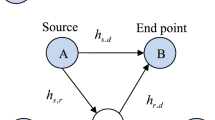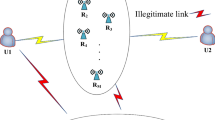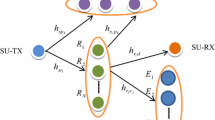Abstract
In this paper, a machine learning schemes are proposed to enhance the physical layer security in cognitive radio network in the presence of an eavesdropper and primary user. Firstly, we apply the support vector machine (SVM) based scheme as a machine learning based scheme to classify and select a relay node to assist the secondary user transmitter (SU-Tx) and maximize the secrecy rate and satisfy the interference constraint at PU. Then, we develop a deep neural network (DNN) based scheme to classify and select the best relay to assist the SU-Tx. Compared to the conventional optimal selection (OS) scheme, we prove that the proposed DNN-based scheme can achieve the same secrecy performance and the proposed scheme can substantially reduce the feedback overhead. Moreover, the proposed scheme based on SVM can achieve a good performance with small complexity compared to DNN and conventional OS. In contrast, the conventional OS requires knowledge of the eavesdropper's channel, which is impractical, whereas the proposed scheme based on DNN and SVM do not assume knowledge of the eavesdropper's channel so our proposed scheme is less complex with a small feedback overhead, e.g., at least 58% feedback overhead could be reduced.




Similar content being viewed by others
References
Yang, P., Xiao, Y., Xiao, M., & Li, S. (2019). 6G wireless communications: Vision and potential techniques. IEEE Network, 33(4), 70–75.
Tariq, F., Khandaker, M. R. A., Wong, K. K., Imran, M. A., Bennis, M., & Debbah, M. (2020). A speculative study on 6g. IEEE Wireless Communications, 27(4), 118–125.
Mitola, J., & Maguire, G. Q. (1999). Cognitive radio: Making software radios more personal. IEEE Personal Communications, 6(4), 13–18.
Liu, Y., Chen, H., & Wang, L. (2017). Physical layer security for next generation wireless networks: theories, technologies, and challenges. IEEE Commun Surv Tutor, 19(1), 347–376.
Wyner, A. D. (1975). The wire-tap channel. Bell System Technical Journal, 54(8), 1355–1387.
Alves H, Souza RD, Debbah M (2011) Enhanced physical layer security through transmit antenna selection. In: 2011 IEEE GLOBECOM workshops (GC Wkshps), pp 879–883
Krikidis, I. (2010). Opportunistic relay selection for cooperative networks with secrecy constraints. IET Communications, 4(15), 1787–1791.
OShea, T., & Hoydis, J. (2017). An introduction to deep learning for the physical layer. IEEE Trans Cognit Commun Network, 3(4), 563–575.
Joung, J. (2016). Machine learning-based antenna selection in wireless communications. IEEE Communications Letters, 20(11), 2241–2244.
Amiri R, Mehrpouyan H, Fridman L, Mallik RK, Nallanathan A, Matolak D (2018) A machine learning approach for power allocation in hetnets considering QoS. In: 2018 IEEE international conference on communications (ICC), pp 1–7
Drner, S., Cammerer, S., Hoydis, J., & Brink, S. T. (2018). Deep learning based communication over the air. IEEE J Sel Topics Signal Process, 12(1), 132–143.
Sakran H (2020) Joint relay and jammer selection based on deep learning for improving the physical layer secrecy in cooperative networks. In: IEEE IWCMC 2020 Conference
Sun, Y., Peng, M., Zhou, Y., Huang, Y., & Mao, S. (2019). Application of machine learning in wireless networks: Key techniques and open issues. IEEE Commun Surv Tutor, 21(4), 3072–3108.
Sakran, H., Shokair, M., Nasr, O., El-Rabaie, S., & El-Azm, A. A. (2012). Proposed relay selection scheme for physical layer security in cognitive radio networks. IET Communications, 6(16), 2676–2687.
Author information
Authors and Affiliations
Corresponding author
Additional information
Publisher's Note
Springer Nature remains neutral with regard to jurisdictional claims in published maps and institutional affiliations.
Rights and permissions
About this article
Cite this article
Sakran, H. Relay selection scheme based on machine learning for enhancing the physical layer secrecy in cognitive radio networks. Telecommun Syst 78, 267–272 (2021). https://doi.org/10.1007/s11235-021-00806-w
Accepted:
Published:
Issue Date:
DOI: https://doi.org/10.1007/s11235-021-00806-w




